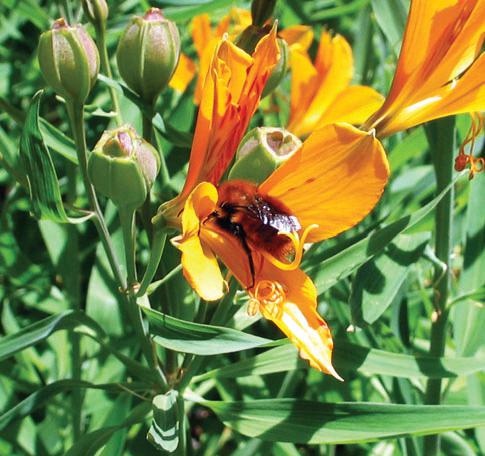Carolina Laura Morales
The aim of the project is to explore whether the transmission of pathogens from introduced invasive bumblebees to the native bumblebee Bombus dahlbomii might explain the long term decline of this native species.

The native bumble bee Bombus dahlbomii.
Bombus dahlbomii, the southern-most and largest bumblebee species worldwide, is the unique native Bombus species inhabiting the Temperate Forest of Southern South America, where it is a key pollinator of endemic flora. In NW Patagonia, Argentina populations of this species experienced a strong decline during the last 15 years. This population decay started simultaneously with the invasion and thriving of European bumblebees Bombus ruderatus and B. terrestris, which were introduced for crop pollination in the neighbour country Chile. This pattern suggests that alien Bombus species are displacing their native congener; nevertheless the mechanisms underlying this ecological replacement are unknown.
Along with competition for resources, pathogen transmission from introduced to native species has been proposed as an underlying mechanism of native bumblebees decline in other parts of the world, where non- native bumblebees have been released. However, there is very little information on the presence of parasites in native and alien Bombus spp. in our region, and on whether or not parasites have been carried and spread by introduced Bombus species. Thus, our aim is to identify endoparasites in the native and introduced bumblebee species, and to evaluate whether a potential “pathogen spillover” from introduced to native bumblebees might be involved in the population crash of B. dahlbomii. Understanding the underlying mechanism (Competition, interspecific pathogens trasmission, or a combination of both) of ecological replacement of Bombus dahlbomii by introduced Bombus ruderatus and Bombus terrestris is a first step to design appropriate and sound conservation programmes for this species.
In addition and more generally, our results will increase the awareness necessary to prevent further spread of pathogens hosted by commercially reared bumblebees to other regions of the world that have healthy populations of native bumblebees. For achieving our goal, along with my colleague and co-worker Marina Arbetman, we will sample specimens of the three species from different locations along the proposed invasional pathway within the Nahuel Huapi and Lanin National Parks in NW Patagonia, Argentina. DNA extraction and PCR reactions will be performed in extracts of stomach and tracheal content with specific primers for several endoparasites that have been already identified and sequenced in both non-native bumblebees. After setting up the reactions, with both positive and negative controls for each parasite, we will perform retrospective analyses to detect those parasites in old well-preserved collections of B. dahlbomii captured before the invasion of B. ruderatus and B. terrestris.